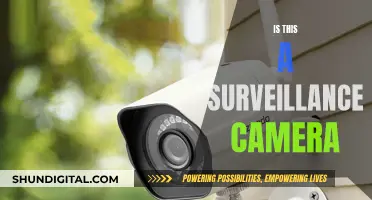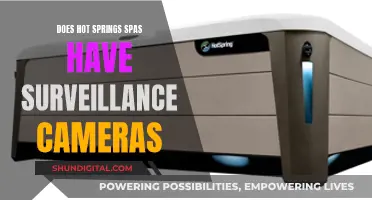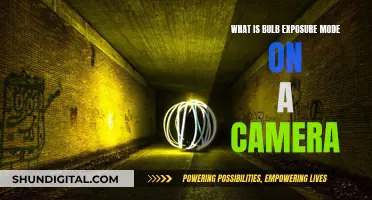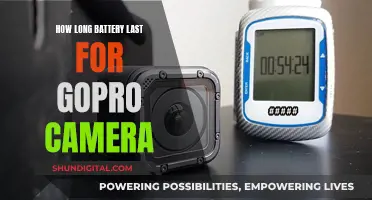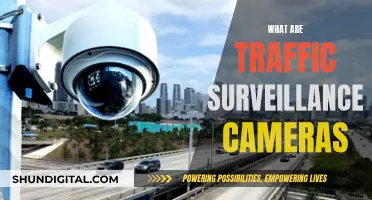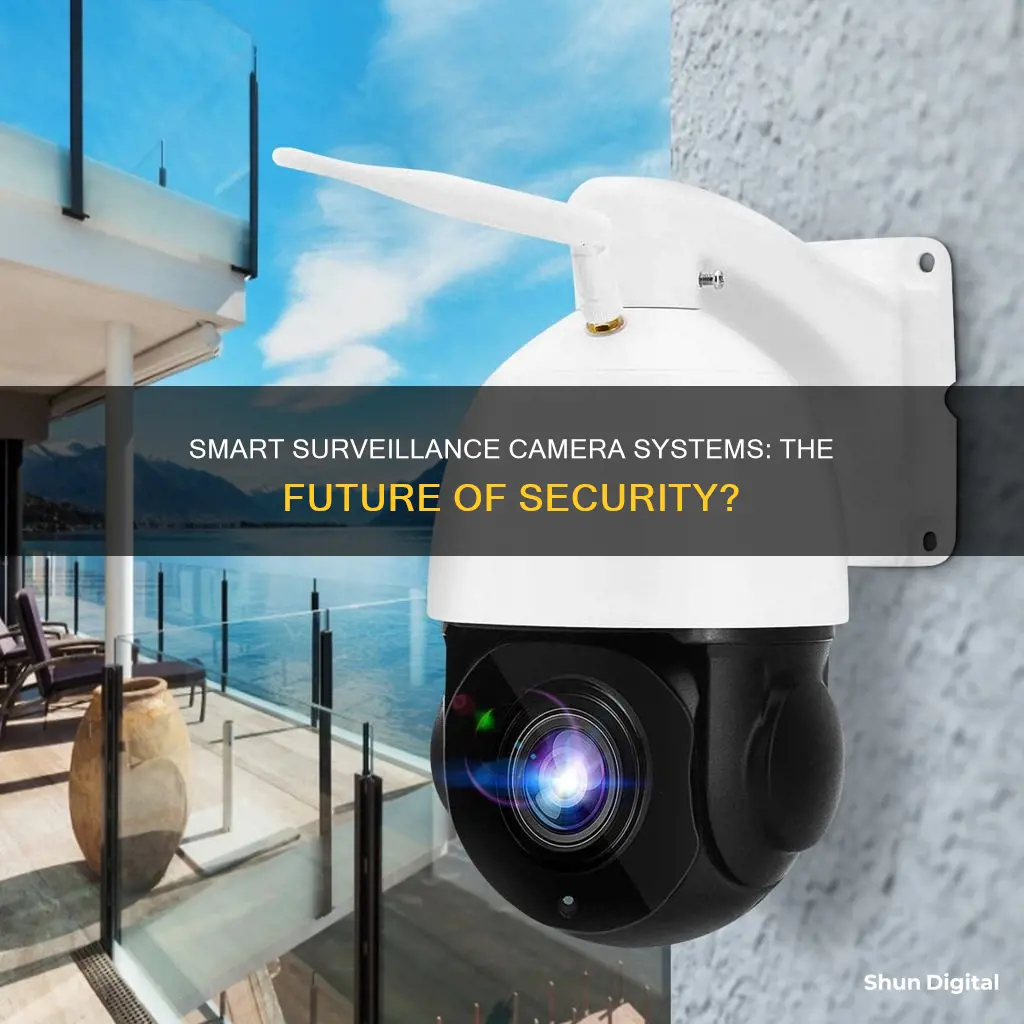
Smart surveillance refers to the use of advanced technologies such as sensors, networking, cloud computing, and intelligent data processing algorithms to create sophisticated surveillance systems that can easily extract application-specific intelligence from captured data. Smart surveillance systems are used in smart cities, smart homes, and smart controls, among other things. There are a variety of smart security cameras on the market, with features such as motion detection, night vision, and cloud storage.
What You'll Learn

Indoor vs. outdoor cameras
There are several differences between indoor and outdoor cameras. The primary distinction is that outdoor cameras need to be able to withstand weather conditions and varying light conditions. They are also more vulnerable to being tampered with, so they are typically made from more durable materials, like metal, and may be heavier or housed in a casing.
Outdoor cameras are usually larger and more noticeable, acting as a visual deterrent. They are also often housed in domes, which are designed to keep onlookers from knowing exactly where the lens is pointed. Domes also provide an extra level of protection for cameras that are mounted outside. Some outdoor cameras even come with blowers and heaters to provide extra protection against the elements.
Indoor cameras, on the other hand, can be smaller, more lightweight, and less intrusive. They are often designed to be more subtly placed and less visible. They are also usually located in a climate-controlled environment, so they don't need to be as durable or weatherproof.
Another difference is that outdoor cameras are more likely to have advanced dynamic range and low-light capabilities, allowing them to see in complex lighting situations and adapt to changes in lighting. However, with advancements in technology, many indoor cameras now also have these capabilities.
It's important to note that, while there are cameras designed specifically for indoor or outdoor use, there are also many cameras that can be used for both, such as dome cameras and PTZ cameras.
Moonlite Focuser: Capturing the Moon's Rotation
You may want to see also

Wired vs. wireless cameras
Smart surveillance camera systems are available in both wired and wireless options. Here is a detailed comparison of the two:
Installation and Placement
Wireless security cameras are generally easier and quicker to install, requiring minimal or no drilling and wiring work. They are ideal for DIY setups and can be placed in various locations within the range of the central unit, offering greater flexibility in terms of placement and repositioning. On the other hand, wired security cameras require more labour-intensive installation due to the need for running cables, and they have limited flexibility in terms of placement due to cable constraints. Wired cameras are typically fixed in place after installation and are harder to conceal.
Power Source
Wireless security cameras can be powered by batteries or plugged into electrical outlets, while wired security cameras are wired directly into the home's electricity source, providing a consistent power supply. Battery-powered wireless cameras may require frequent maintenance to replace or recharge batteries, while wired cameras do not require battery changes. Wired cameras can also use Power over Ethernet (PoE) technology, which provides data and power over a single Ethernet cable.
Reliability and Signal Interference
Wired security cameras are generally more reliable as they have a constant power source and experience minimal to no interference from nearby devices. They are less susceptible to signal interference and hacking attempts. Wireless cameras, on the other hand, may experience signal loss or interference due to distance, obstructions, or other wireless devices. They are more vulnerable to hacking if not properly secured with strong passwords and encryption.
Video and Audio Quality
Wired security cameras can transmit higher-resolution video with less compression, resulting in better video quality. Wireless cameras offer good-quality video and audio but may experience reduced resolution. However, with advancements in technology, wireless cameras can now provide high-quality video and audio comparable to wired cameras.
Cost
The cost of wired and wireless security cameras varies depending on the specific product and features. Wired cameras typically have lower equipment costs but may require professional installation, increasing the overall cost. Wireless cameras may have higher equipment costs but generally have lower installation costs since they do not require extensive cabling.
Suitability
Wired security cameras are recommended for businesses or larger properties that require high-quality video and audio, reliable power sources, and enhanced security against hacking. Wireless security cameras are ideal for residential use, smaller businesses, or temporary installations, offering convenience, flexibility, and easy installation.
Charging Your 4K Dual Action Camera: A Quick Guide
You may want to see also

Cloud vs. local storage
When it comes to smart surveillance camera systems, there are two main types of storage options: local storage and cloud storage. Both have their own advantages and disadvantages, and the best choice for you will depend on your specific needs and preferences.
Local Storage
Local storage keeps your surveillance footage on your device and your property, without sending any data over the internet. This means you don't need an internet connection or have to pay monthly fees for the camera to function. Local storage also offers better security, as the footage is stored on a memory card, and enhanced video quality, as it is not compressed to preserve storage space. Additionally, local storage has lower long-term costs, as memory cards are relatively affordable.
However, local storage is vulnerable to camera or recorder theft, has limited storage capacity, and may require the purchase of additional equipment such as a server or recorder. It can also be bulky and may need maintenance due to the multiple components required to operate.
Cloud Storage
Cloud storage, on the other hand, stores your surveillance footage on remote servers that can be accessed via the internet. This provides easy remote access to users, who can browse footage from their smart devices. Cloud storage is also scalable, with customizable storage capacity to meet individual needs. Additionally, cloud servers protect surveillance footage using safeguards such as single sign-on, password protection, and two-step authentication.
However, cloud storage usually requires a monthly subscription fee, and there may be unpredictable gaps in coverage if the internet connection is unreliable. Cloud storage also consumes high bandwidth and can be costly for businesses with sophisticated surveillance needs, as the storage fees are based on the amount of data stored.
Hybrid-Cloud Security Camera Systems
A third option is a hybrid-cloud security camera system, which offers a balance between local and cloud storage. These systems provide low-cost and low-bandwidth video storage on-premises, great accessibility through direct access from a web browser, and optional cloud backup for important cameras. They also allow for unlimited archives of important video clips to the cloud, ensuring crucial footage is stored securely and indefinitely.
Both local and cloud storage options have their advantages and disadvantages, and the right choice for you will depend on your specific needs and preferences. Local storage is generally more affordable and does not require an internet connection, while cloud storage offers convenience and a backup layer if something happens to your camera. Hybrid-cloud systems provide a balance between the two, offering low-cost and accessible on-premises storage with the added security of cloud backups. Ultimately, the decision between local, cloud, or hybrid storage for your smart surveillance camera system will depend on your budget, storage needs, and preference for control over your data.
Fight Camera Speeding Tickets in Maryland: Payment Options
You may want to see also

AI-powered cameras
Some AI-powered cameras can even track and follow moving objects. For instance, the Ecobee SmartCamera has a panning function that can keep moving objects in the centre of the frame.
AI technology in security cameras will only get better over time, and it has the potential to significantly enhance the effectiveness of surveillance systems.
Moto Z Camera Mod: Compatibility and Fit
You may want to see also

Camera resolution
There are several standard resolution options available for surveillance cameras, including:
- Quarter CIF (QCIF): This resolution is a quarter of the size of CIF (Common Intermediate Format), with half the height and width.
- 2CIF: This resolution is twice the width and height of CIF.
- 720p High Definition: This is often referred to as HD or "HD-SDI".
- 960p High Definition: This is a Sony-specific HD standard, also known as "1 Megapixel" or "1MP".
- 1080p High Definition: This resolution is commonly used in CCTV applications and is considered high-definition.
- 2 Megapixel: Captures 1,920,000 pixels per frame.
- 3 Megapixel: Captures 3,145,728 pixels per frame.
- 4K: Refers to a horizontal resolution of approximately 4,000 pixels, providing an ultra-high-definition image.
When choosing a smart surveillance camera system, it is important to consider the specific requirements of your application. For example, if you need facial recognition or license plate reading capabilities, a higher resolution camera may be necessary. Additionally, the platform you are using may limit your resolution options, as different platforms have varying capabilities. Analog cameras, for instance, transmit over coaxial cables and can capture up to 700 lines, while IP cameras transmit over CAT5 cables.
It is also worth noting that higher resolution cameras will require more bandwidth and hard drive space for video storage. Therefore, it is essential to consider the cost and feasibility of upgrading your infrastructure to accommodate higher-resolution footage.
Camera Battery Control Board: What's Inside?
You may want to see also
Frequently asked questions
Smart surveillance cameras can help protect your home or business in two main ways. Firstly, they act as a deterrent to trespassers. Secondly, they can alert you to suspicious movement around your property, even when you are away.
When choosing a smart surveillance camera system, consider whether you need indoor or outdoor cameras, or a combination of both. Other features to look out for include motion detection, night vision, local and cloud storage, and compatibility with smart home devices.
Some of the best smart surveillance camera systems include the Arlo Pro 5S, the Google Nest Cam, the Ring Stick Up Cam Battery, the Blink Indoor, and the TP-Link Tapo Pan/Tilt C210 Camera.
The cost of smart surveillance camera systems can vary depending on the features and quality you are looking for. Basic cameras can be found for as little as $20, while more advanced systems can range from $100 to $200 or more.
One potential concern with smart surveillance camera systems is the possibility of hacking. It is important to take steps to secure your cameras and protect your privacy, such as using strong passwords and keeping your firmware up to date.


